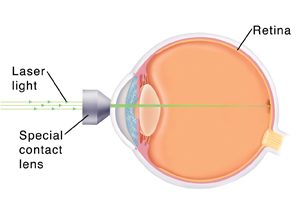Diabetic Retinopathy: Having Laser Treatment
Diabetic Retinopathy: Laser Treatment
Diabetic retinopathy is a condition that happens when diabetes damages blood vessels in the rear of the eye, in the retina. It can lead to vision loss or even blindness. However, a treatment called laser photocoagulation may help slow or stop the disease. Laser treatment can't always be used for diabetic retinopathy. Sometimes eye surgery is needed.
What is laser photocoagulation?
Laser photocoagulation uses a laser (high-energy light source) to control the growth of new blood vessels in the eye. A laser beam is focused on the retina. The heat from the laser beam causes scarring that decreases the growth of new blood vessels. New capillary growth is slowed or stopped with the procedure. Lasers may also cause inflammation. This promotes the healing process and the absorption of extra fluid. Laser photocoagulation is done using one or more of the types of laser treatments listed below. Sometimes laser treatment is combined with medicine, such as injections of steroids or blood vessel inhibitors into the eye (such as anti-VEGF medicines).
Types of laser treatment
The type of treatment you receive depends on the extent and location of damaged capillaries. Treatment may take from a few minutes to a half hour or so. You may need more than one treatment session or type of treatment. Treatments include the following:
Panretinal treatment reduces growth of new capillaries throughout the retina (the inside lining of the back of the eye).
Grid treatment treats swelling in different areas of the macula (a spot in the middle of the retina responsible for clear vision).
Focal treatment seals up small areas of leakage in the retina.
Preparing for laser treatment
Tell your healthcare provider about all medicines, herbal remedies, and supplements you take. This includes aspirin, ibuprofen, ginkgo, warfarin, or other blood thinners. Be sure to have an adult family member or friend drive you home after laser surgery. You should also bring dark sunglasses to wear on the way home.
During laser treatment
Laser treatment may be done at the healthcare provider’s office, hospital, or eye center. You’ll be awake during the procedure. First, the healthcare provider uses eye drops to widen (dilate) your pupil. Then drops are placed to numb the surface of the eye. He or she then places a special contact lens on your eye to help focus the laser treatment on the retina. You will be asked to fixate on a light with your other eye so that your eyes stay still and do not move during the laser treatment. Once the laser treatment is completed, the lens is removed.
After laser treatment
You may be given an eye patch to wear, usually for just a few hours, but sometimes for a few days. You may also be instructed to use eye drops. There usually is no need to stop taking blood-thinning medicines. However, if you were instructed to do so, ask your healthcare provider when you can resume taking them. Ask your healthcare provider how long you need to avoid lifting, exercising, or swimming. Also, ask when you can drive and return to work.
Controlling pain
Laser treatment rarely causes pain. You’ll be given medicine to treat eye irritation, if it happens. If you have significant eye pain or discomfort call your healthcare provider.
Risks and complications of laser treatment
Laser treatment risks and complications include the following:
Eye irritation
Bleeding in the retina
Retinal detachment
Corneal abrasion
Watery eyes
Dilated pupils
Mild headache
Double or blurry vision
Decreased vision
Seeing spots
Problems with glare
Loss of night or side (peripheral) vision
When to call your healthcare provider
If you have sudden pain or notice decreasing vision after laser treatment surgery, call your eye healthcare provider right away.
Updated:
October 29, 2017
Sources:
Diabetic retinopathy: Prevention and treatment. UpToDate
Reviewed By:
Brown, Kim, APRN,Hurd, Robert, MD,Image reviewed by StayWell medical illustration team.
